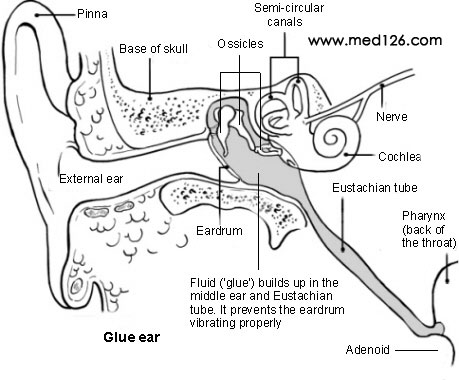What is the ear like and how do we hear?
The ear is divided into three parts - the outer, middle, and inner ear. Sound waves come into the outer (external) ear and hit the eardrum causing the eardrum to vibrate. Behind the eardrum, in the middle ear, are three tiny bones (ossicles) - the malleus, incus, and stapes. The vibrations pass from the eardrum to these middle ear bones. The bones then transmit the vibrations to the cochlea in the inner ear. The cochlea converts the vibrations to sound signals which are sent down the ear nerve to the brain which we 'hear'.
The middle ear behind the eardrum is normally filled with air. The middle ear is connected to the back of the nose by a thin channel, the Eustachian tube. This tube is normally closed. However, from time to time (usually when we swallow, chew or yawn), it opens to let air into the middle ear, and to drain any fluid out.
What is glue ear?
Glue ear is a condition where the middle ear becomes filled with fluid that looks like glue. It can affect one or both ears. The fluid dampens the vibrations of the eardrum and bones (ossicles) made by the sound waves. The cochlea receives dampened vibrations, and so the 'volume' of the hearing is 'turned down'. Glue ear usually occurs in young children, but it can develop at any age.

What causes glue ear?
The exact cause is not clear. It is probably due to the Eustachian tube not working properly. The balance of fluid and air in the middle ear may become altered if the Eustachian tube is narrow, blocked, or does not open properly. Air in the middle ear may gradually pass into the nearby cells if it is not replaced by air coming up the Eustachian tube. A vacuum may then develop in the middle ear. This may cause fluid to seep into the middle ear from the nearby cells.
Some children develop glue ear after a cough, cold, or ear infection when extra mucus is made. The mucus may build up in the middle ear and not drain well down the Eustachian tube. However, in many cases glue ear does not begin with an ear infection.
How common is glue ear?
It is common. More than 7 in 10 children have at least one episode of glue ear before they are four years old. In most cases it only lasts a short while. Boys are more commonly affected than girls. It is more common in children who:
Dulled hearing
This is the main problem. Hearing does not go completely. The hearing loss can vary from mild to severe, and can vary from day to day. Older children may say if their hearing is dulled. However, dulled hearing in a younger child may not be noticed at first by parents or teachers, particularly if only one ear is affected. You may find that your child turns the TV or radio up loud, or often says 'what' or 'pardon' when you talk to them. Babies may appear less responsive to normal sounds.
Pain
This is not usually a main symptom, but mild earache may occur from time to time. Children and babies may pull at their ears if they have mild pain. However, the gluey fluid is a good food for bacteria (germs), and ear infections are more common in children with glue ear. This may then cause bad earache for the duration of an infection. Always have some painkiller in your home in case earache develops.医学全在.线提供
Development and behaviour may be affected in a small number of cases
If dulled hearing is not noticed then children may not learn so well at school if they cannot hear the teacher. They may also become frustrated if they cannot follow what is going on. They may feel left out of some activities. Some children become quiet and withdrawn if they cannot hear so well. 医学 全在.线提供www.med126.com
There has been some concern that dulled hearing from glue ear may cause problems with speech and language development. This in turn was thought to perhaps lead to poor school achievement and behaviour problems. However, research studies that have looked at this issue are reassuring. The studies looked at aspects of the development and behaviour of children with glue ear and compared them with children without glue ear. The studies showed that, on average, children with glue ear had no more chance (or just a little more chance) of having long term behaviour problems or poor school performance compared to children without glue ear. However, these studies looked at the overall average picture. There is still a concern that the development of some individual children with glue ear may be affected. In particular, some children with untreated severe and persistent glue ear, and some children with glue ear who already have learning difficulties.
If you have any concern about your child's development, you should tell a doctor.
How does glue ear progress?
The outlook is usually good. Many children only have symptoms for a short time (a few weeks or so). The fluid often drains away gradually, air returns, and hearing then returns to normal.
Are any tests needed?
A referral to an ear, nose, and throat (ENT) specialist may be advised at some point. This may be straight away for babies who have hearing loss. (This is to rule out other serious causes of hearing loss.) It may be after a period of 'watchful waiting' in older children who previously had good hearing. Hearing tests and ear tests can confirm the cause of hearing loss and show how bad the hearing has become.